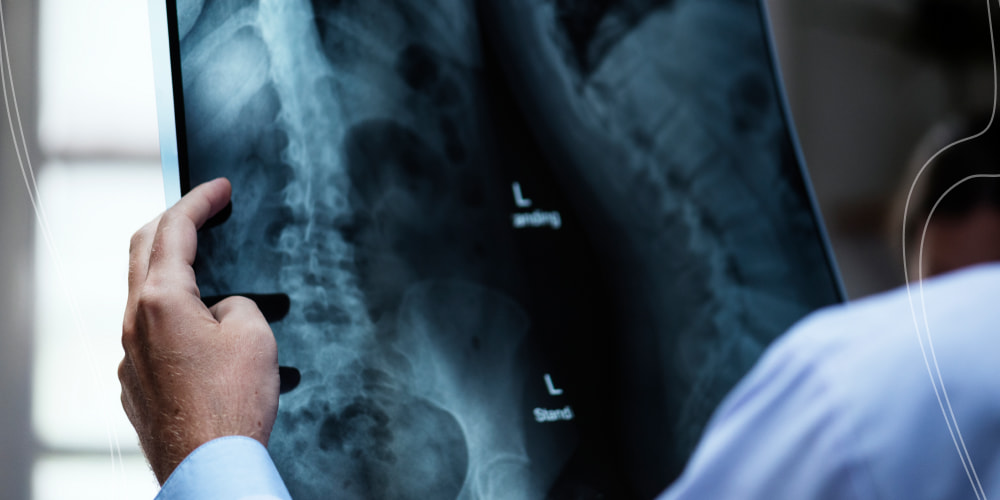The term syringomyelia includes various conditions that are characterized by damage to the spinal cord with the formation of abnormal fluid-filled cavities.
Cavities in the spinal cord can be the result of a spinal cord injury, a spinal tumor, or a congenital anomaly. Also described in the clinic is the idiopathic form of the syrinx (a form of the disease without a specific cause). Fluid-filled cavities slowly expand and lengthen over time, resulting in progressive damage to the nerve centers of the spinal cord due to the pressure exerted by the fluid. This injury results in pain, weakness, and stiffness in the back, shoulders, arms, or legs. Syringomyelia patients can have a different combination of symptoms. In many cases, the syrinx is combined with an anomaly of the foramen magnum, where the lower part of the medulla oblongata is located, which connects the brain and spinal cord. Syrinx is often combined with Chiari malformation, in which part of the brain is displaced down to the medulla oblongata, thus reducing the spinal central canal. Familial cases of syrinx are also sometimes observed.
The types:
- with communication with the fourth ventricle;
- due to CSF block (without connection with the fourth ventricle);
- due to spinal cord injury;
- syrinx and spinal dysraphism (incomplete closure of the neural tube);
- due to intramedullary tumors;
- idiopathic syrinx;
- syrinx occurs in about eight out of every 100,000 people. The onset of the disease is most often noted between the ages of 25 and 40. Rarely, syringomyelia can develop in childhood or old age. Men get this disease more often than women. No geographic or racial dependence was noted.
Symptoms and causes of syringomyelia pain
Symptoms
The patient should pay attention to the following changes in his body:
- Loss of pain (and temperature) sensitivity in certain areas of the skin, primarily in the upper half of the body.
- The spread over time of insensitive areas throughout the body, alternating with normal areas.
- Deep pains of unknown origin, which seem to shoot unexpectedly in different parts of the body.
- Persistent, increasing weakness in the muscles, starting in the hands.
- Dryness, flaking, and bluish tint of the skin due to weakening of peripheral circulation, a sharp deterioration in the condition of the nails.
Causes
The causes of syrinx remain unknown. At present no theory can correctly explain the basic mechanisms of the formation of cysts and cystic enlargements.
- One theory suggests that syrinx occurs as a result of the pulsating pressure of the cerebrospinal fluid between the fourth ventricle of the brain and the spinal central canal.
- Another theory suggests that cysts develop due to differences in intracranial pressure and spinal pressure, especially in the presence of Chiari malformation.
- The third theory suggests that the formation of cysts is caused by the tonsils of the cerebellum, acting as a piston and there is a large pressure drop of the cerebrospinal fluid in the subarachnoid space, and this action of the forces of fluid affects the spinal cord.
It usually progresses slowly, and the course of the disease stretches for years. But sometimes there is an acute course of the disease, especially when the brain stem is involved.
Diagnostics and treatment of syringomyelia pain
Diagnostics
Diagnosis begins with a medical history and a complete physical examination.
At the initial visit, the doctor will examine the patient for the presence of four main symptomatic groups of syringomyelia:
- The presence of a complex of congenital malformations called dysgraphic status: split palate, cleft lip, deformities of the skull, spine – in 90% of patients with syringomyelia;
- Sensitivity disorders of any type, primarily temperature and pain sensitivity – in 100% of patients with syringomyelia, however, may not always be noticeable to the patient;
- Various disorders of motor function: weakness in the hands, up to paralysis – in 90% of patients with syringomyelia;
- Vegetative-trophic syndrome – in 60% of patients with syringomyelia.
Sometimes syringomyelia is an accidental finding during MRI (magnetic resonance imaging) or CT (computed tomography) of the spine for another reason.
If you suspect syringomyelia, your doctor is likely to order the following tests:
- MRI of the spine and spinal cord is the most reliable tool in this diagnosis. During an MRI, radio waves and a strong magnetic field are used to produce detailed images of the spine and spinal cord. In some cases, contrast enhancement is used – a specialist injects a dye into a blood vessel, which goes along the circulatory system to the spine and allows you to detect tumors or other anomalies. MRI is repeated periodically to monitor the progression of the disease.
- CT – A series of X-rays are used to display the spine and spinal cord in detail. CT can detect tumors or other pathologies of the spine.
Treatment
Syringomyelia treatment, usually surgical, is aimed at arresting the progression of the spinal cord injury and maintaining functionality.
- Surgical procedures are often performed when there is spinal cord compression.
- In addition, surgical procedures are performed to correct deformities.
- Operations were also performed to implant fetal tissues to close the cystic formations.
- Surgical treatment results in stabilization or moderate improvement in symptoms in most patients.
- Many doctors believe that surgical treatment is only necessary for patients with progressive neurologic symptoms.
- Delay in surgical treatment in cases where the disease progresses can lead to irreversible damage to the spinal cord and gross persistent neurological damage.
Medication (vasoconstrictors) is often prescribed to reduce swelling around the spinal cord. It is often recommended to avoid vigorous physical activity that can increase venous pressure. Some exercises, such as forward bending of the trunk, can reduce the risk of cystic enlargement. Life expectancy in patients with progressive symptoms without surgery ranges from 6 to 12 months.
Rehabilitation and prognosis of syringomyelia pain
Recovery and rehabilitation
Despite reports of complete neurological recovery after surgery, most patients manage to achieve stabilization or only moderate improvement in symptoms. Syringomyelia in children is characterized by much less pronounced sensory and pain disorders than in adults, but a much higher risk of developing scoliosis, which is more favorable for surgical treatment. In addition, syrinx does not progress equally in all patients. For some with milder symptoms, symptoms stabilize for a year. A frequent complication of the progression of symptoms is the patient’s need to adapt to life due to impairment or loss of some functions. These adjustments can lead to a loss of quality of life. The goal of rehabilitation is the maximum possible preservation of functionality using exercises and adaptive equipment, or, especially in the case of syringomyelia in children, measures should be aimed at correcting scoliosis.
Prognosis
The prognosis for patients depends on the underlying cause of the cyst and the type of treatment. Untreated cases of the syrinx in 35-50% of cases have a prognosis for long-term survival. Patients who underwent surgical bypass surgery for spinal cord injury experienced long-term pain relief and better survival. Recent studies have shown an unsatisfactory long-term prognosis due to the high rate of recurrence of cyst formation in other forms of syringomyelia. Surgical treatment (posterior decompression) associated with Chiari malformation is considered a fairly effective treatment with a high chance of clinical improvement. In children, surgical treatment is effective for stabilizing scoliosis.






 (8 votes, average: 3.88 out of 5)
(8 votes, average: 3.88 out of 5)







Please, leave your review
Write a comment: